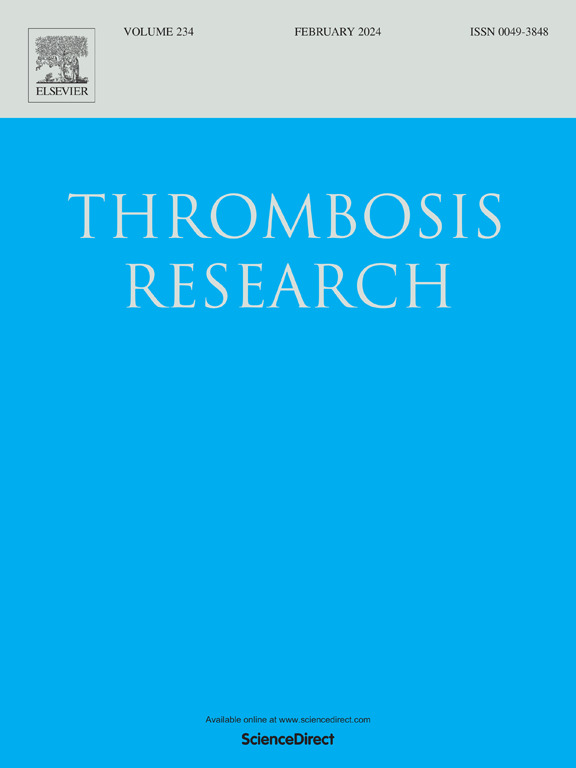Clinical utility of thrombin generation using ST-Genesia® in patients with hereditary and acquired thrombophilia: A cross-sectional study
IF 3.4
3区 医学
Q1 HEMATOLOGY
引用次数: 0
Abstract
Background
The role of thrombin generation (TG) in the setting of thrombophilia testing remains unclear. Hence, we aimed to investigate the diagnostic utility of TG with ST-Genesia® instrument to discriminate between patients with and without different thrombophilias.
Methods
We conducted a single-center cross-sectional study of all non-anticoagulated patients who underwent conventional thrombophilia testing for factor V Leiden, prothrombin gene G20210A mutation (PTM), protein C, S and antithrombin deficiency (PCD, PSD, ATD), and antiphospholipid antibody syndrome (APS) because of previous venous thromboembolism (VTE), unexplained arterial thrombosis or a positive family history for VTE. To assess the diagnostic utility of TG, we calculated the area under the receiver operating curve (AUC), thresholds for 85 %, 95 % and 99 % sensitivity and specificity, positive and negative predictive values and likelihood ratios, cohort-related diagnostic failure and efficacy rates and the diagnostic yield of each TG parameter for different thrombophilias.
Results
A total of 467 patients were enrolled in the study, mostly investigated because of previous VTE (n = 283, 61 %). Thrombophilia testing was positive in 161/467 (35 %) patients. Normalized endogenous thrombin potential (ETP) effectively discriminated for ATD (AUC =79 [95 %CI 72–87]) and PTM (AUC 86 [95 %CI 79–93]) and ETP inhibition with thrombomodulin for PCD/PSD (AUC 90 [95 %CI 85–95]). With the established best performing TG parameter cut-offs, PCD/PSD, PTM, ATD, and low-risk APS could be safely (<3 % failure rate) excluded in 62 %, 58 %, 27 %, and 29 % of cohort patients, respectively.
Conclusions
TG assessment using ST-Genesia® system shows promise as a supportive screening tool in thrombophilia work-up and warrants further validation.
ST-Genesia®用于遗传性和获得性血栓患者凝血酶生成的临床应用:一项横断面研究
背景:凝血酶生成(TG)在血栓形成试验中的作用尚不清楚。因此,我们的目的是研究TG与ST-Genesia®仪器在区分不同血栓形成患者和非血栓形成患者中的诊断效用。方法:我们对所有因既往静脉血栓栓塞(VTE)、不明原因动脉血栓形成或VTE阳性家族史而接受常规血栓形成检测的非抗凝患者进行单中心横断研究,包括V Leiden因子、凝血酶原基因G20210A突变(PTM)、蛋白C、S和抗凝血酶缺乏症(PCD、PSD、ATD)和抗磷脂抗体综合征(APS)。为了评估TG的诊断效用,我们计算了受试者工作曲线下面积(AUC), 85%、95%和99%敏感性和特异性阈值,阳性和阴性预测值和似然比,队列相关的诊断失败率和有效率,以及不同血栓性疾病的每个TG参数的诊断率。结果:共有467例患者入组,其中大多数因既往静脉血栓栓塞而接受调查(n = 283, 61%)。467例患者中有161例(35%)的血栓检测呈阳性。归一化内源性凝血酶电位(ETP)可有效鉴别ATD (AUC =79 [95% CI 72-87])和PTM (AUC 86 [95% CI 79-93]), ETP被血栓调节素抑制可有效鉴别PCD/PSD (AUC 90 [95% CI 85-95])。有了已建立的最佳TG参数截止值,PCD/PSD、PTM、ATD和低风险APS可以安全地进行(结论:使用ST-Genesia®系统进行TG评估有望作为血栓性疾病检查的支持性筛查工具,值得进一步验证。
本文章由计算机程序翻译,如有差异,请以英文原文为准。
求助全文
约1分钟内获得全文
求助全文
来源期刊

Thrombosis research
医学-外周血管病
CiteScore
14.60
自引率
4.00%
发文量
364
审稿时长
31 days
期刊介绍:
Thrombosis Research is an international journal dedicated to the swift dissemination of new information on thrombosis, hemostasis, and vascular biology, aimed at advancing both science and clinical care. The journal publishes peer-reviewed original research, reviews, editorials, opinions, and critiques, covering both basic and clinical studies. Priority is given to research that promises novel approaches in the diagnosis, therapy, prognosis, and prevention of thrombotic and hemorrhagic diseases.
 求助内容:
求助内容: 应助结果提醒方式:
应助结果提醒方式:


